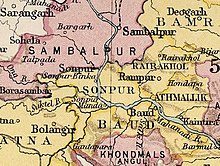| Baudh State | |||||||
|---|---|---|---|---|---|---|---|
| Princely State of British India | |||||||
| 14th century–1948 | |||||||
Flag | |||||||
 Baudh State in the Imperial Gazetteer of India | |||||||
| Area | |||||||
• 1921 | 3,274 km2 (1,264 sq mi) | ||||||
| Population | |||||||
• 1921 | 130,103 | ||||||
| History | |||||||
• Established | 14th century | ||||||
| 1948 | |||||||
| |||||||
Baudh State, also known as Boudh State, was one of the princely states of India during the British Raj. It was recognized as a state in 1874 and had its capital in Boudh town. Its last ruler signed the document of accession to the Indian Union on 1 January 1948.
